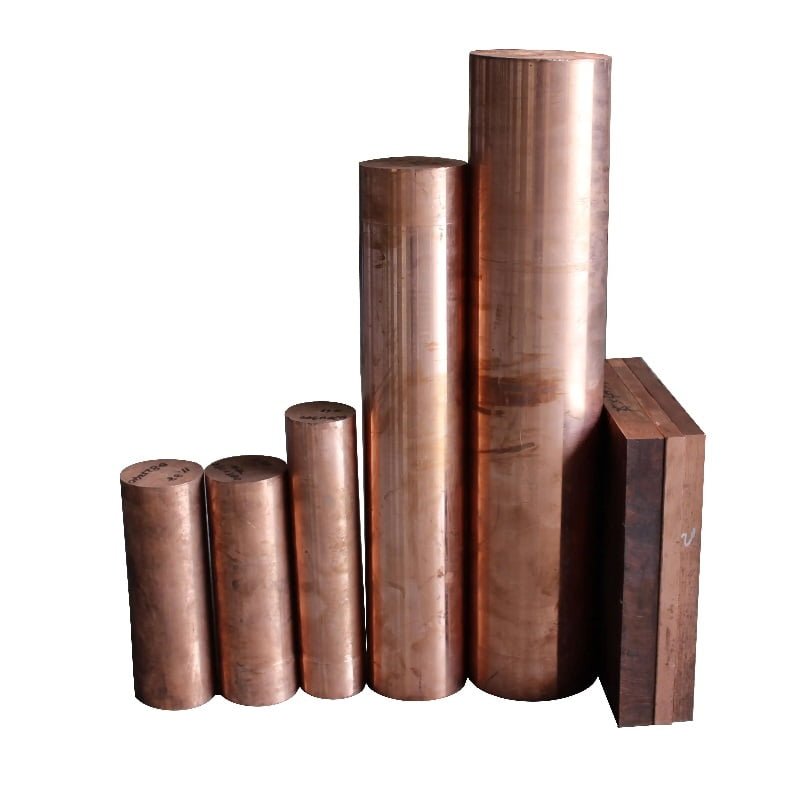
C18150 und C18200 sind beide Kupferchrom-Zirkonium-Legierungen, die häufig in industriellen Anwendungen verwendet werden, bei denen hohe Festigkeit, elektrische Leitfähigkeit und Korrosionsbeständigkeit von entscheidender Bedeutung sind. Während sie aufgrund ihrer Legierungszusammensetzung Ähnlichkeiten teilen, gibt es wichtige Unterschiede zwischen C18150 und C18200, die ihre spezifischen Anwendungen und Leistungsmerkmale beeinflussen.
Legierungszusammensetzung
- Kupfer (mit): Ungefähr 97,5% min
- Chrom (Cr): 0.50-1,50%
- Zirkonium (ZR): 0.10-0,50%
- Andere Elemente: Es können kleine Mengen anderer Elemente wie Eisen (Fe) und Phosphor (P) vorhanden sein.
C18200:
- Kupfer (mit): Ungefähr 96,0% min
- Chrom (Cr): 1,20-2,00%
- Zirkonium (ZR): 0.10-0,60%
- Andere Elemente: Es können kleine Mengen anderer Elemente wie Eisen (Fe) und Phosphor (P) vorhanden sein.
Hauptunterschiede
1. Chromgehalt:
- C18150: Enthält 0,50-1,50% Chrom.
- C18200: Enthält 1,20-2,00% Chrom.
Der höhere Chromgehalt in C18200 (im Vergleich zu C18150) bietet im Allgemeinen eine erhöhte Festigkeit und Härte sowie eine verbesserte Resistenz gegen Korrosion und Verschleiß. Dies macht C18200 für Anwendungen geeignet, bei denen höhere mechanische Eigenschaften und eine bessere Korrosionsbeständigkeit erforderlich sind.
2. Elektrische Leitfähigkeit:
- C18150: Aufgrund des niedrigeren Chromgehalts ist in der Regel eine geringfügige elektrische Leitfähigkeit im Vergleich zu C18200 aufweist. Dies macht C18150 für Anwendungen geeignet, bei denen eine hohe elektrische Leitfähigkeit kritisch ist, z. B. in elektrischen Kontakten und leitfähigen Komponenten.
3.. Mechanische Eigenschaften:
- C18200: Mit seinem höheren Chromgehalt hat C18200 im Vergleich zu C18150 tendenziell höhere Festigkeit und Härte. Dies macht C18200 für Anwendungen geeigneter, die gute mechanische Eigenschaften erfordern, z. B. in Schweißelektroden, Widerstandsschweißkomponenten und Schimmelpilzeinsätzen.
4. Wärmeleitfähigkeit:
- Beide Legierungen haben eine gute thermische Leitfähigkeit, was ein typisches Merkmal von Kupferlegierungen ist. Die Zugabe von Chrom und Zirkonium beeinflusst die thermische Leitfähigkeit im Vergleich zu reinem Kupfer nicht signifikant, wodurch diese Legierungen für Anwendungen geeignet sind, die eine effiziente Wärmeübertragung erfordern.
Anwendungen
C18150:
- Elektrische Kontakte: Aufgrund seiner hohen elektrischen Leitfähigkeit und eines guten Widerstands gegen die Erweichen bei erhöhten Temperaturen wird C18150 üblicherweise in elektrischen Kontakten, Anschlüssen und Klemmen verwendet.
- Schweißelektroden: Die hervorragende Wärme- und Verschleißfestigkeit macht C18150 zum Schweißen von Elektroden und anderen Beständigkeitsschweißkomponenten geeignet.
- Schimmelpilzeinsätze: In Injektionsformanwendungen wird C18150 für Formeinsätze verwendet, bei denen eine gute Wärmeleitfähigkeit und Verschleißfestigkeit erforderlich sind.
C18200:
- Widerstandsschweißkomponenten: Seine höhere Festigkeit und Härte machen C18200 ideal für Widerstandsschweißkomponenten, Elektroden und Spitzen.
- Plastikform: C18200 wird in Kunststoffeinspritzformen verwendet, bei denen seine Härte und seine Verschleißfestigkeit vorteilhaft sind.
- Wärmetauscherplatten: Die Korrosionsbeständigkeit und seine thermische Leitfähigkeit machen C18200 für Wärmetauscherplatten und Flossen geeignet.
Leistungsmerkmale
- Korrosionsbeständigkeit: Sowohl C18150 als auch C18200 weisen eine gute Korrosionsbeständigkeit auf, was für ihre Verwendung in verschiedenen industriellen Umgebungen unerlässlich ist.
- Bearbeitbarkeit: Kupferchrom-Zirconium-Legierungen sind im Allgemeinen messbar, was die Herstellung komplexer Formen und Komponenten ermöglicht.
- Schweißbarkeit: Diese Legierungen können mit Standardschweißtechniken geschweißt werden, die für Kupferlegierungen geeignet sind.
Fazit
Während C18150 und C18200 beide Kupfer-Chrom-Zirkonium-Legierungen sind, die in ähnlichen industriellen Anwendungen verwendet werden, machen sie ihre spezifischen Zusammensetzungen und Eigenschaften für verschiedene Arten von Anwendungen geeignet. C18200 mit höherem Chromgehalt bietet im Vergleich zu C18150 eine überlegene Festigkeit und Härte, was eine etwas höhere elektrische Leitfähigkeit aufweist. Die Wahl zwischen diesen Legierungen hängt von den spezifischen Anforderungen der Anwendung ab, wie z. B. mechanische Festigkeit, elektrische Leitfähigkeit, Korrosionsbeständigkeit und thermischen Eigenschaften. Das Verständnis dieser Unterschiede ermöglicht es Ingenieuren und Designern, die am besten geeignete Legierung für eine optimale Leistung und Langlebigkeit in ihren jeweiligen Anwendungen auszuwählen.
